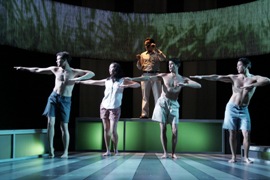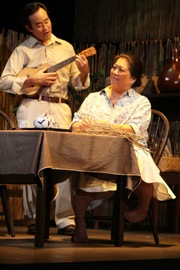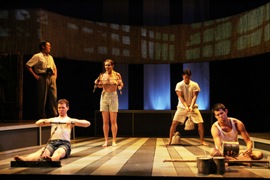
In the time-honored tradition of fact-based underdog sports tales like Hoosiers, We Are Marshall, and the recent Moneyball, East West Players now presents the Mainland Premiere of Three Year Swim Club, Lee Tonouchi’s crowd-pleasing true story of a Hawaiian swim coach and the ragtag band of Maui plantation kids he is bound and determined to send to the 1940 Olympics.
Blake Kushi is coach Soichi Sakamoto, who has a mere three years to take non-swimmers Keo (Jared Asato), Halo (Kelsey Chock), Fudge (Mapuana Makia) and Bill (Chris Takemoto-Gentile) and mold them into champions—without benefit of swimming pool since the only one around is on the local sugar cane plantation and For Haole Only, i.e. no Polynesian or Japanese Hawaiians allowed.
What Coach Sakamoto does have up his sleeve are such scientifically inspired strength-building techniques as weight lifting, relaxation exercises, and having his Olympic hopefuls practice their various strokes while swimming against the current in the plantation’s irrigation ditches, techniques unheard of before the fledgling coach introduced them to the swimming world.
Each of Three Year Swim Club’s four-member team has his or her own reason for undertaking Coach’s challenge. For Keo, becoming a champion swimmer might lead to a university scholarship, his only alternative to spending the rest of his life following in his parents’ footsteps as a plantation worker. Self-declared ladies man Halo has joined the team in hopes of catching glimpses of pretty girls in swimsuits. Fudge is tired of being picked on by her macho brothers and sees swimming as a way of establishing her own identity apart from her family of men. Half-Caucasian Bill has had enough of being an outsider, not Hawaiian enough for the natives nor white enough for the Haoles. Not surprisingly, competitive friction develops between the three strapping males, with each one vying for top-dog status and for Fudge’s affections.
Meanwhile back at home, Coach’s wife Mary (Kaliko Kauahi) wonders to her dreamer of a husband, “What do we get out of this? Is anything going to be different for us?”, even as radio news flashes reveal an outside world moving step by step closer to war, an early consequence of which is the Olympic Committee’s decision to move the 1940 games from Tokyo to Helsinki. Is it possible that a world at war could lead to the outright cancelation of the games, thereby ending the Olympic dreams of Coach and his swim team?
Much of Three Year Swim Club’s charm comes from the Hawaiian Pidgin spoken by its characters, who substitute “one” for “a” and “for” for “to” in addition to sprinkling their sentences with Hawaiian words (explained in a program insert glossary), though fortunately the playwright has tempered this island speech for mainland ears.
Under Hawaiian-born Woolford’s assured direction, Hawaii natives Asato, Chock, Kauahi, Kushi, Makia, and Takemoto-Gentile couldn’t be more charming and winning in their portrayals of 3YSC’s quirkily amusing characters.
If Three Year Swim Club were a multimillion-dollar movie, there would doubtless be great panoramic views of Hawaiian landscapes as backdrops to edge-of-your-seat racing sequences, with long-shots and close-ups and underwater filming upping the dramatic suspense.
East West Players has considerably less kala at their disposition than a Hollywood studio, but Three Year Swim Club Live benefits from an abundance of imagination provided by director-choreographer Woolford and a stellar design team.
Inspired by EWP Players’ Producing Artistic Director Tim Dang’s suggestion, Woolford translates swimming into graceful, hula-inspired moves, accompanied by rhythmic chants like “Kick Kick Reach Pull, Kick Kick Exhale,” while from Coach and Mary’s kitchen, Kauahi marks the beats on a big Hawaiian gourd. The effect is quite often breathtaking.
Scenie-winning scenic and projection designer Adam Flemming makes imaginative use of bamboo in his multi-level/mulit-locale set and as a backdrop for projections which further set the scene, and, in the production’s affecting final moments, show us black-and-white photos of the real Keo, Halo, Fudge, Bill, and Coach. Jeremy Pivnick’s lighting provides a perfect complement to the above, as do Ken Takemoto’s period Hawaiian costumes. Dennis Yen’s rich sound design, and Ken Takemoto’s clever props, with special kudos due his ingenious homemade weights and strength-training “contraptions.” Maya Rogers is stage manager.
Three Year Swim Club The Movie would make a terrific addition to the underdog sports film oeuvre. (Producers take note.) Still, there’s something particularly special about the theatricality of East West Players’ delightful live staging. As both history lesson and losers-turned-winners tale, Three Year Swim Club works quite niftily indeed.
East West Players, David Henry Hwang Theatre, 120 Judge John Aiso St., Los Angeles.
www.eastwestplayers.org
–Steven Stanley
February 15, 2012
Photos: Michael Lamont





 Since 2007, Steven Stanley's StageSceneLA.com has spotlighted the best in Southern California theater via reviews, interviews, and its annual StageSceneLA Scenies.
Since 2007, Steven Stanley's StageSceneLA.com has spotlighted the best in Southern California theater via reviews, interviews, and its annual StageSceneLA Scenies.







 COPYRIGHT 2024 STEVEN STANLEY :: DESIGN BY
COPYRIGHT 2024 STEVEN STANLEY :: DESIGN BY